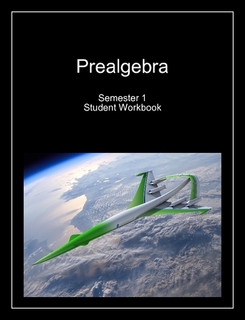|
|
Prealgebra

|
|
|
Description
This course will cover the topics normally covered in a middle school prealgebra course. This course is normally taken by students in grade seven or eight, and is designed to prepare students for Algebra 1. A detailed course outline is shown below.
|
Lectures and Class Time
Class time will primarily be spent on instruction. Students should bring their Student Workbook to each class, or a printout of the pages for that week. The pages of the workbook are identical to the instructor's lecture notes, except the student version has the solutions and answers deleted. During the lecture the students take notes and solve the example problems in the workbook.
Videos of the lectures are also available online, and these videos go through the same lecture notes, point by point. Students use the videos to cover any material that time constraints did not permit us to cover in our weekly class. Or, if a student misses a class or needs to review the material, all of the course content is available online. It is possible to take the entire course online via distance learning, and many students have done so.
|
Textbook
The complete content of the course is in the lecture videos and the Student Workbook. The textbook is no longer necessary. This course originally used Prealgebra, An Integrated Equations Approach by Donald Hutchison, published by McGraw Hill, for homework and practice problems. Complete sets of problems, along with full solutions, are now included in the Student Workbook.
|
Homework, Tests and Grades
Students will be given specific assignments to complete each week. Assignments will consist of study and practice from the textbook, instructional videos online, and written assignments.
In this class there is a distinction between Practice Problems and Homework Problems. Practice problems are assigned in the textbook and in the workbook, and students check their answers with the solutions provided. Homework assignments and tests are printed from the website, completed, and turned in for a grade.
To maximize instructional time in class, tests will be given at home. One final exam for each semester will be taken in class at the end of each semester. Students will receive a numerical grade for each semester and for the year. The grade is calculated based on tests, graded homework and the final exams.
|
Internet Access
Access to a computer with a high speed internet connection is strongly recommended, and is required for distance learning. Instructional materials such as lecture videos, lecture notes, homework assignments and tests will be available over the internet. Graded assignments and tests may also be returned via email in order to provide more timely feedback. Progress reports will be put on the website and updated regularly.
|
The Instructor
Derek Owens graduated from Duke University in 1988 with a degree in mechanical engineering and
physics. He taught physics, honors physics, AP Physics, and AP computer science at The Westminster Schools
in Atlanta, GA from 1988-2000. He worked at the TIP program at Duke for two years, teaching physics and
heading the Satellite Science Program. He received a National Science Foundation scholarship and
studied history and philosophy of science at L'Abri Fellowship in England. He worked as a software
developer for six years before returning to teaching. Since 2006, he has been a full time teacher for
homeschoolers in the Atlanta area. He and his wife Amor and their two children Claire and David
attend Dunwoody Community Church, a non-denominational church near their home in Norcross, GA.
|
Course Outline
These topics comprise the material normally taught in a prealgebra course.
- Chapter 1: Whole Numbers
Numbers, Place Value, Addition and Subtraction, Rounding, Estimation, Ordering, Multiplication and Division, Exponents, Order of Operations, Equations
-
Chapter 2: Integers and Introduction to Algebra
Operations on Integers, Variables and Expressions, Introduction to Linear Equations
-
Chapter 3: Fractions and Equations
Prime Numbers, Factorization, Equivalent Fractions, Multiplication and Division of Fractions, Linear Equations in One Variable
-
Chapter 4: Applications of Fractions and Equations
Addition and Subtraction of Fractions, Mixed Numbers, Complex Fractions, Applications of Fractions, Equations with Fractions
-
Chapter 5: Decimals
Place Value, Rounding, Addition and Subtraction of Decimals, Multiplication and Division of Decimals, Fractions and Decimals, Equations with Decimals, Square Roots, The Pythagorean Theorem
-
Chapter 6: Rate, Ratio, and Proportion
Ratios, Rates, Proportions, Similar Triangles and Proportions, Applications of Proportions, Measurement and Conversion
-
Chapter 7: Percent
Percents, Decimals, Fractions, Percent Problems and Proportions, Applications of Percents, Equations with Percentages, Simple and Compound Interest
-
Chapter 8: Geometry
Lines, Angles, Perimeter, Circumference, Area, Volume
-
Chapter 9: Graphing and Introduction to Statistics
Circle Graphs, Pictographs, Bar Graphs, Line Graphs, Rectangular Coordinates, Linear Equations in Two Variables, Mean, Median, Mode
-
Chapter 10: Polynomials
Introduction to Polynomials, Addition and Subtraction of Polynomials, Multiplication of Polynomials
|
|
|
|
